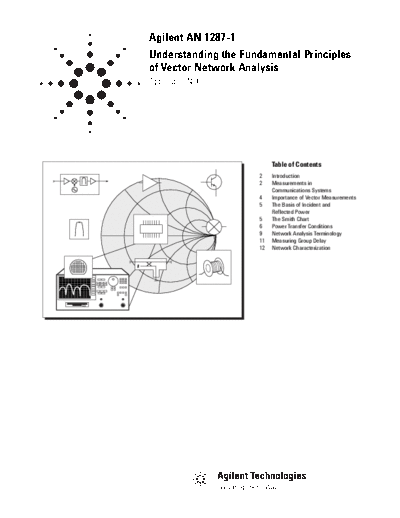Service Manuals, User Guides, Schematic Diagrams or docs for : HP Publikacje 5965-7707E
<< Back | HomeMost service manuals and schematics are PDF files, so You will need Adobre Acrobat Reader to view : Acrobat Download Some of the files are DjVu format. Readers and resources available here : DjVu Resources
For the compressed files, most common are zip and rar. Please, extract files with Your favorite compression software ( WinZip, WinRAR ... ) before viewing. If a document has multiple parts, You should download all, before extracting.
Good luck. Repair on Your own risk. Make sure You know what You are doing.
Image preview - the first page of the document

>> Download 5965-7707E documenatation <<
Text preview - extract from the document
Agilent AN 1287-1
Understanding the Fundamental Principles
of Vector Network Analysis
Application Note
Table of Contents
2 Introduction
2 Measurements in
Communications Systems
4 Importance of Vector Measurements
5 The Basis of Incident and
Reflected Power
5 The Smith Chart
6 Power Transfer Conditions
9 Network Analysis Terminology
11 Measuring Group Delay
12 Network Characterization
Introduction
Network analysis is the process by which designers and manufacturers meas-
ure the electrical performance of the components and circuits used in more
complex systems. When these systems are conveying signals with information
content, we are most concerned with getting the signal from one point to
another with maximum efficiency and minimum distortion. Vector network
analysis is a method of accurately characterizing such components by measur-
ing their effect on the amplitude and phase of swept-frequency and swept-
power test signals.
In this application note, the fundamental principles of vector network analysis
will be reviewed. The discussion includes the common parameters that can
be measured, including the concept of scattering parameters (S-parameters).
RF fundamentals such as transmission lines and the Smith chart will also be
reviewed.
Agilent Technologies offers a wide range of both scalar and vector network
analyzers for characterizing components from DC to 110 GHz. These instru-
ments are available with a wide range of options to simplify testing in both
laboratory and production environments.
Measurements in Communications Systems
In any communications system, the effect of signal distortion must be consid-
ered. While we generally think of the distortion caused by nonlinear effects
(for example, when intermodulation products are produced from desired carrier
signals), purely linear systems can also introduce signal distortion. Linear sys-
tems can change the time waveform of signals passing through them by alter-
ing the amplitude or phase relationships of the spectral components that make
up the signal.
Let's examine the difference between linear and nonlinear behavior more
closely.
Linear devices impose magnitude and phase changes on input signals (Figure 1).
Any sinusoid appearing at the input will also appear at the output, and at the
same frequency. No new signals are created. Both active and passive nonlinear
devices can shift an input signal in frequency or add other frequency compo-
nents, such as harmonic and spurious signals. Large input signals can drive
normally linear devices into compression or saturation, causing nonlinear
operation.
A * Sin 360◦ Jabse Service Manual Search 2024 ◦ Jabse Pravopis ◦ onTap.bg ◦ Other service manual resources online : Fixya ◦ eServiceinfo